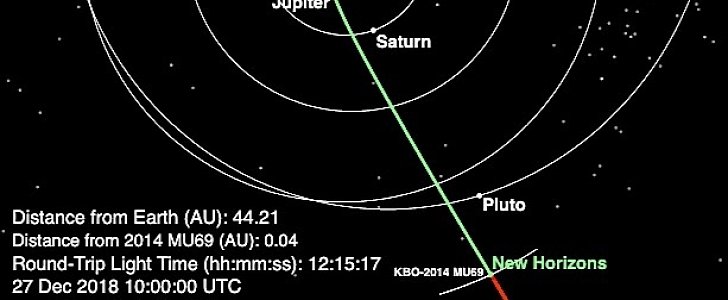What better way for NASA to kick off what will surely be a defining year for space exploration than by reaching a historic milestone?
Billions of miles away from Earth, a human-made spacecraft is approaching a rather small ball of ice and rock. When the two will meet, on January 1, the small ball, affectionately known as Ultima Thule, will become the farthest celestial object ever explored by humanity.
The ship up for the task is, of course, the New Horizons, the same craft that brought us not so long ago the very first close-ups of Pluto. Having long passed this distant planet, New Horizons has ventured into the Kuiper Belt looking for its next target.
Ultima Thule, known to scientists as (486958) 2014 MU69, is a trans-Neptunian object (TNO) likely to be composed of two bodies that have gravitated toward each other until they came together.
The piece of rock measures 30 kilometers (19 miles) in diameter and was chosen as a target after it became the first solar system object to have been discovered after the New Horizons launch in 2006.
Visiting it might allow scientists to better understand how the solar system we call home came to be. Also, the fact that Ultima Thule will become the first ever Kuiper Belt object to be studied leaves enough room (and hope) that great surprises will be uncovered.
Already there is reason to believe something strange lies just around the corner. According to Inverse, scientists are puzzled by the fact that Ultima Thule isn’t reflecting light as an object of its type should. And even though there are reasonable explanations for this, having to deal with a mystery so early on does nothing but to entice researchers even further.
As for the ship to take a closer look at this rock and its puzzles, New Horizons has been for years the fastest spaceship ever launched by humanity. Its domination was only broken this year when the Parker Solar Probe was launched.
The ship up for the task is, of course, the New Horizons, the same craft that brought us not so long ago the very first close-ups of Pluto. Having long passed this distant planet, New Horizons has ventured into the Kuiper Belt looking for its next target.
Ultima Thule, known to scientists as (486958) 2014 MU69, is a trans-Neptunian object (TNO) likely to be composed of two bodies that have gravitated toward each other until they came together.
The piece of rock measures 30 kilometers (19 miles) in diameter and was chosen as a target after it became the first solar system object to have been discovered after the New Horizons launch in 2006.
Visiting it might allow scientists to better understand how the solar system we call home came to be. Also, the fact that Ultima Thule will become the first ever Kuiper Belt object to be studied leaves enough room (and hope) that great surprises will be uncovered.
Already there is reason to believe something strange lies just around the corner. According to Inverse, scientists are puzzled by the fact that Ultima Thule isn’t reflecting light as an object of its type should. And even though there are reasonable explanations for this, having to deal with a mystery so early on does nothing but to entice researchers even further.
As for the ship to take a closer look at this rock and its puzzles, New Horizons has been for years the fastest spaceship ever launched by humanity. Its domination was only broken this year when the Parker Solar Probe was launched.

